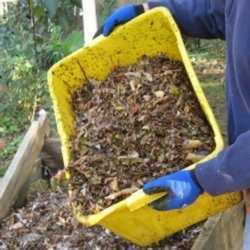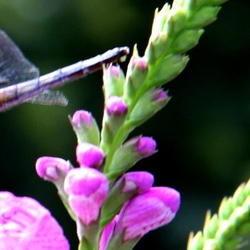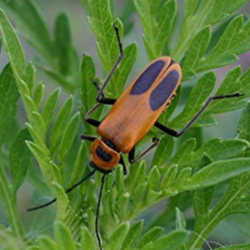Look at that lovely insect to the right. Doesn't it resemble a small wasp with pretty white feet? It's actually a Black Soldier Fly (Hermetia illucens.) Soldier flies have made themselves quite at home in many a suburban compost, whether the bin's owner is aware or not. The internet is abuzz with discussion of "BSF" (black soldier fly) larvae. Chicken owners welcome them, to the point of buying special growing chambers for the tiny beasts. But worm bin owners are wary of these same creatures. Gardeners should embrace (figuratively, of course!) these interesting, beneficial flies.
Black soldier flies are common in the continental United States, and part of a large fly family, Stratiomyidae.
 Soldier flies aren't well known. That, no doubt, is because they lack the kind of offensive behaviors that make "housefly" and "mosquito" household words. Stratiomyidae larvae devour moist, decaying, nitrogen-rich organic matter. The larvae are buff colored to tan, with obvious segments (rings around the body) and bristles, and grow up to 3/4 inch long. They have a pointy wiggly head and a blunt tail end. (You're forgiven for not getting close enough to see the bristles and ends.) They are quite wigggly when warm and well fed. These larvae are voracious eaters. They chow down so effectively that nuisance flies, like fungus gnats and houseflies, cannot get a seat at the table. Soldier fly larvae will nearly eliminate houseflies and fruit flies around composting areas.
Soldier flies aren't well known. That, no doubt, is because they lack the kind of offensive behaviors that make "housefly" and "mosquito" household words. Stratiomyidae larvae devour moist, decaying, nitrogen-rich organic matter. The larvae are buff colored to tan, with obvious segments (rings around the body) and bristles, and grow up to 3/4 inch long. They have a pointy wiggly head and a blunt tail end. (You're forgiven for not getting close enough to see the bristles and ends.) They are quite wigggly when warm and well fed. These larvae are voracious eaters. They chow down so effectively that nuisance flies, like fungus gnats and houseflies, cannot get a seat at the table. Soldier fly larvae will nearly eliminate houseflies and fruit flies around composting areas.
 The adult flies are timid and may look like some sort of wasp hovering or resting near the compost. Even with hundreds of larvae squirming in the bin, only a few adult flies will be seen at any one time. The black soldier fly pictured above is just over half an inch long. Yellow soldier flies (genus Ptecticus) are also common in North America. Smaller than BSF, they have a golden thorax, tan wings, gorgeous hazel eyes, and short yellow antennae.
The adult flies are timid and may look like some sort of wasp hovering or resting near the compost. Even with hundreds of larvae squirming in the bin, only a few adult flies will be seen at any one time. The black soldier fly pictured above is just over half an inch long. Yellow soldier flies (genus Ptecticus) are also common in North America. Smaller than BSF, they have a golden thorax, tan wings, gorgeous hazel eyes, and short yellow antennae.
Soldier flies do not bite, sting, or otherwise make pests of themselves. According to most sources, adult soldier flies do not feed at all. Their brief adult life is spent mostly on reproduction. Eggs are laid near rotting matter, like juicy kitchen scraps or animal manures. Soldier fly larvae eat for about two weeks. Then they crawl out of the compost, into nearby soil or dry matter, and form a pupa. Emerging adult flies will have no trouble finding the compost bin to continue the circle of life. Adult soldier flies become inactive during cold months. Pupae can overwinter.
Soldier flies love coffee grounds
Curious composters who don't seem to have a population of soldier flies can attract them easily using coffee. BSF love coffee grounds. Collect a gallon or two of used coffee grounds and put them on the compost. Make sure the grounds stay moist. Dig into the grounds after a week and check for small tan wriggly "worms." If you're successful, supplement the herd by adding kitchen waste, more coffee grounds, or spoiled fruit or vegetables. The waste these larvae make is very moist. This waste can be diluted into a compost "tea" to use in the garden, or help the breakdown of "brown" compost material.
Chicken owners love soldier flies
Black soldier fly larvae (BSFL) make a nutritious "home grown" feed supplement and treat for chickens. Soldier flies can even help process the waste from the chicken bedding. Chickens can hunt the larvae themslves, or chicken owners can invest in, or design, a special growing chamber for BSFL. The chamber capitalizes on the larvae's instinct to crawl out of the food source when they are fully grown. Crawling larvae are channeled into a collection bucket, or right into the hungry chickens' foraging area.
Worm bin owners do not like soldier flies
Worms don't like BSF. The fly larvae are so active that they make the compost soggy, warm, and slightly acidic. Worms don't like these conditions. Those who raise worms should take care not to overload the worm bin with the kind of fresh, nitrogenous waste that soldier flies are drawn to. Existing fly larvae can be lured into a feeding frenzy under moistened bread or a cut open vegetable. After a day or two, check the food lure and remove the swarming larvae.
Cozy in the compost bin
Back to the compost bin: soldier fly larvae inhabiting the home compost should be viewed as neutral to beneficial. These larvae discourage pest flies, and are fantastic consumers of rotting wastes. After eating their fill, soldier fly larvae crawl away to virtually disappear. As adults, they renew the supply of larvae, and become a food source for birds and small creature. Adult soldier flies do not invade living quarters, and they do not carry pathogens from manure to food items. If soldier flies inhabit a compost, it is because they are exploiting a natural niche and speeding the transformation of waste to something that supports green plants. We humans suffer an innate aversion to anything remotely "maggotty," but soldier fly larvae are harmless to humans and domestic animals, and helpful in a compost bin well supplied with fresh green waste.

















